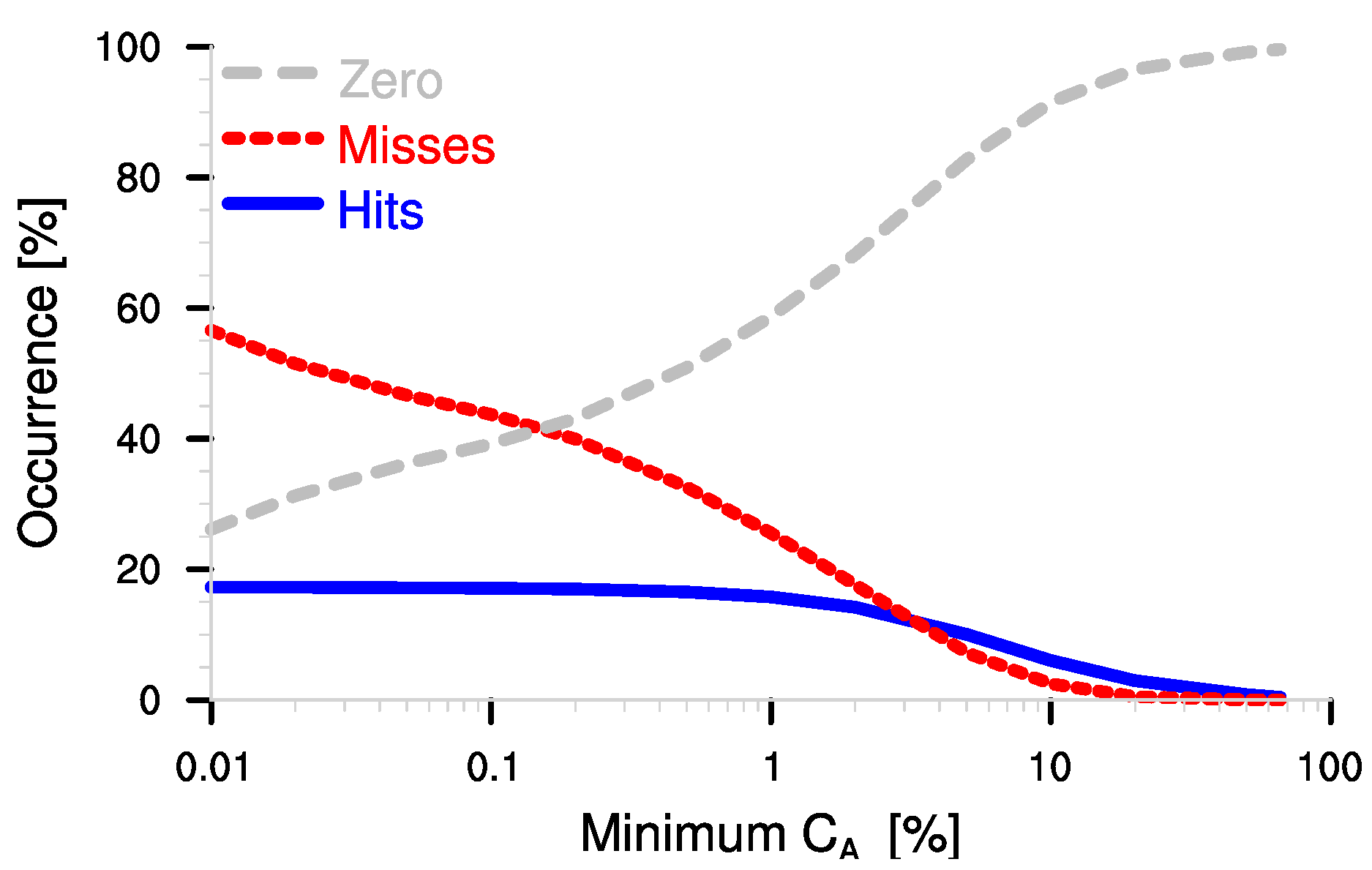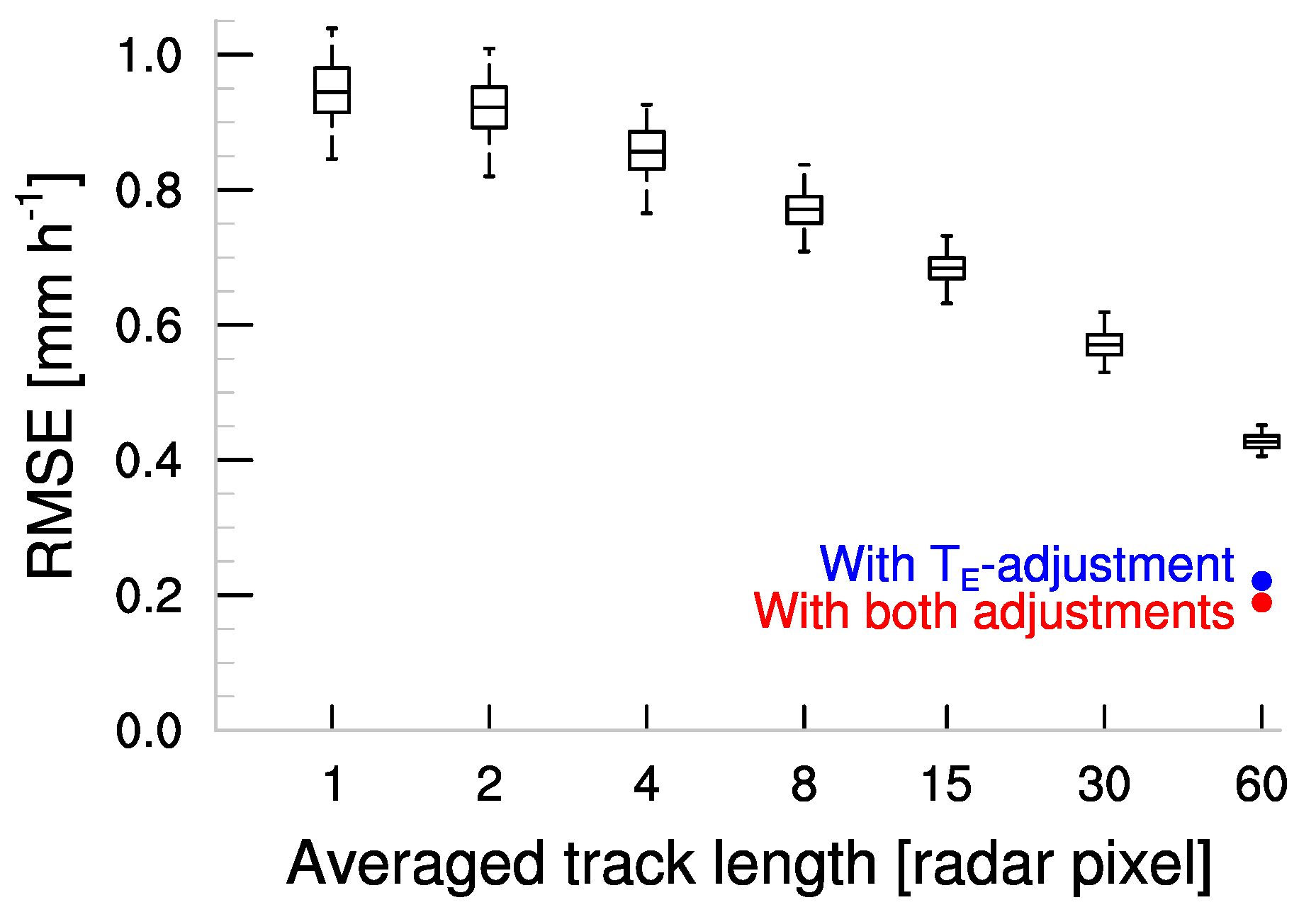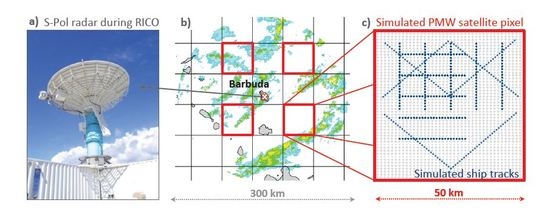Simulation of Ship-Track versus Satellite-Sensor Differences in Oceanic Precipitation Using an Island-Based Radar
Abstract
:1. Introduction
2. Data and Methods
2.1. The S-Pol Radar
2.2. The Simulation Framework
2.3. Weather Conditions during RICO
3. Results
3.1. Detection of Precipitation along Ship Tracks
3.2. Rain-Rate Representation along Simulated Ship Tracks
3.3. Proposed Statistical Track-to-Area Adjustment
4. Summary and Concluding Remarks
Acknowledgments
Author Contributions
Conflicts of Interest
References
- Epstein, E.S. Point and area precipitation probabilities. Mon. Weather Rev. 1966, 94, 595–598. [Google Scholar] [CrossRef]
- Ciach, G.J.; Krajewski, W.F. On the estimation of radar rainfall error variance. Adv. Water Resour. 1999, 22, 585–595. [Google Scholar] [CrossRef]
- Porcù, F.; Milani, L.; Petracca, M. On the uncertainties in validating satellite instantaneous rainfall estimates with raingauge operational network. Atmos. Res. 2014, 144, 73–81. [Google Scholar] [CrossRef]
- Michaelides, S.; Levizzani, V.; Anagnostou, E.; Bauer, P.; Kasparis, T.; Lane, J. Precipitation: Measurement, remote sensing, climatology and modeling. Atmos. Res. 2009, 94, 512–533. [Google Scholar] [CrossRef]
- Phillips, D.L.; Dolph, J.; Marks, D. A comparison of geostatistical procedures for spatial analysis of precipitation in mountainous terrain. Agric. For. Meteorol. 1992, 58, 119–141. [Google Scholar] [CrossRef]
- Habib, E.; Ciach, G.J.; Krajewski, W.F. A method for filtering out raingauge representativeness errors from the verification distributions of radar and raingauge rainfall. Adv. Water Resour. 2004, 27, 967–980. [Google Scholar] [CrossRef]
- Stoffelen, A. Toward the true near-surface wind speed: Error modeling and calibration using triple collocation. J. Geophys. Res. Oceans 1998, 103, 7755–7766. [Google Scholar] [CrossRef]
- Alemohammad, S.H.; McColl, K.A.; Konings, A.G.; Entekhabi, D.; Stoffelen, A. Characterization of precipitation product errors across the United States using multiplicative triple collocation. Hydrol. Earth Syst. Sci. 2015, 19, 3489–3503. [Google Scholar] [CrossRef]
- Maggioni, V.; Meyers, P.C.; Robinson, M.D. A Review of Merged High-Resolution Satellite Precipitation Product Accuracy during the Tropical Rainfall Measuring Mission (TRMM) Era. J. Hydrometeor. 2016, 17, 1101–1117. [Google Scholar] [CrossRef]
- Klepp, C. The oceanic shipboard precipitation measurement network for surface validation—OceanRAIN. Atmos. Res. 2015, 163, 74–90. [Google Scholar] [CrossRef]
- Kidd, C.; Huffman, G. Global precipitation measurement: Global precipitation measurement. Meteorol. Appl. 2011, 18, 334–353. [Google Scholar] [CrossRef]
- Tapiador, F.J.; Turk, F.; Petersen, W.; Hou, A.Y.; García-Ortega, E.; Machado, L.A.; Angelis, C.F.; Salio, P.; Kidd, C.; Huffman, G.J.; et al. Global precipitation measurement: Methods, datasets and applications. Atmos. Res. 2012, 104, 70–97. [Google Scholar] [CrossRef]
- Bumke, K. Validation of ERA-Interim Precipitation Estimates over the Baltic Sea. Atmosphere 2016, 7, 82. [Google Scholar] [CrossRef]
- Bumke, K.; König-Langlo, G.; Kinzel, J.; Schröder, M. HOAPS and ERA-Interim precipitation over the sea: Validation against shipboard in situ measurements. Atmos. Meas. Tech. 2016, 9, 2409–2423. [Google Scholar] [CrossRef]
- Keeler, R.; Lutz, J.; Vivekanandan, J. S-Pol: NCAR’s polarimetric Doppler research radar. In Proceedings of the 2000 International Geoscience and Remote Sensing Symposium (IGARSS 2000), Honolulu, HI, USA, 24–28 July 2000; Volume 4, pp. 1570–1573. [Google Scholar]
- Rauber, R.M.; Ochs, H.T.; Di Girolamo, L.; Göke, S.; Snodgrass, E.; Stevens, B.; Knight, C.; Jensen, J.B.; Lenschow, D.H.; Rilling, R.A.; et al. Rain in Shallow Cumulus Over the Ocean: The RICO Campaign. Bull. Am. Meteorol. Soc. 2007, 88, 1912–1928. [Google Scholar] [CrossRef]
- Burdanowitz, J.; Nuijens, L.; Stevens, B.; Klepp, C. Evaluating light rain from satellite- and ground-based remote sensing data over the subtropical North Atlantic. J. Appl. Meteorol. Climatol. 2015, 54, 556–572. [Google Scholar] [CrossRef]
- Behrangi, A.; Lebsock, M.; Wong, S.; Lambrigtsen, B. On the quantification of oceanic rainfall using spaceborne sensors. J. Geophys. Res. 2012, 117, 105. [Google Scholar] [CrossRef]
- UCAR/NCAR-Earth Observing Laboratory. S-PolKa: S-band/Ka-band Dual Polarization, Dual Wavelength Doppler Radar. 1996. Available online: https://doi.org/10.5065/D6RV0KR8 (accessed on 29 September 2016).
- Knight, C.A.; Miller, L.J. Early Radar Echoes from Small, Warm Cumulus: Bragg and Hydrometeor Scattering. J. Atmos. Sci. 1998, 55, 2974–2992. [Google Scholar] [CrossRef]
- Snodgrass, E.R.; Di Girolamo, L.; Rauber, R.M. Precipitation Characteristics of Trade Wind Clouds during RICO Derived from Radar, Satellite, and Aircraft Measurements. J. Appl. Meteorol. Climatol. 2009, 48, 464–483. [Google Scholar] [CrossRef]
- UCAR/NCAR-EOL. RICO: S-band Polarimetric (S-Pol) Data DORADE Format. Version 1.0. 2011. Available online: https://data.eol.ucar.edu/dataset/87.008 (accessed on 29 September 2016).
- Max Planck Institute for Meteorology. Climate Data Operators. 2015. Available online: http://www.mpimet.mpg.de/cdo (accessed on 16 May 2017).
- Brueck, M.; Nuijens, L.; Stevens, B. On the Seasonal and Synoptic Time-Scale Variability of the North Atlantic Trade Wind Region and Its Low-Level Clouds. J. Atmos. Sci. 2015, 72, 1428–1446. [Google Scholar] [CrossRef]
- Nuijens, L.; Stevens, B.; Siebesma, A.P. The Environment of Precipitating Shallow Cumulus Convection. J. Atmos. Sci. 2009, 66, 1962–1979. [Google Scholar] [CrossRef]
- Andersson, A.; Fennig, K.; Klepp, C.; Bakan, S.; Graßl, H.; Schulz, J. The Hamburg Ocean Atmosphere Parameters and Fluxes from Satellite Data—HOAPS-3. Earth Syst. Sci. Data 2010, 2, 215–234. [Google Scholar] [CrossRef]
- Fennig, K.; Andersson, A.; Bakan, S.; Klepp, C.P.; Schröder, M. Hamburg Ocean Atmosphere Parameters and Fluxes from Satellite Data—HOAPS 3.2—Monthly Means/6-Hourly Composites. Satell. Appl. Facil. Clim. Monit. (CM SAF) 2012. [Google Scholar] [CrossRef]
- Wagner, P.D.; Fiener, P.; Wilken, F.; Kumar, S.; Schneider, K. Comparison and evaluation of spatial interpolation schemes for daily rainfall in data scarce regions. J. Hydrol. 2012, 464–465, 388–400. [Google Scholar] [CrossRef]
- Burdanowitz, J. Point-to-Area Validation of Passive Microwave Satellite Precipitation with Shipboard Disdrometers. Ph.D. Thesis, Universität Hamburg, Hamburg, Germany, 2017. [Google Scholar]






| All Cases | % | |||
|---|---|---|---|---|
| 17.3 | 61.2 | 14.2 | 17.6 | |
| 0 | 21.5 | 0 | 68.2 | |
© 2017 by the authors. Licensee MDPI, Basel, Switzerland. This article is an open access article distributed under the terms and conditions of the Creative Commons Attribution (CC BY) license (http://creativecommons.org/licenses/by/4.0/).
Share and Cite
Burdanowitz, J.; Klepp, C.; Bakan, S.; Buehler, S.A. Simulation of Ship-Track versus Satellite-Sensor Differences in Oceanic Precipitation Using an Island-Based Radar. Remote Sens. 2017, 9, 593. https://doi.org/10.3390/rs9060593
Burdanowitz J, Klepp C, Bakan S, Buehler SA. Simulation of Ship-Track versus Satellite-Sensor Differences in Oceanic Precipitation Using an Island-Based Radar. Remote Sensing. 2017; 9(6):593. https://doi.org/10.3390/rs9060593
Chicago/Turabian StyleBurdanowitz, Jörg, Christian Klepp, Stephan Bakan, and Stefan A. Buehler. 2017. "Simulation of Ship-Track versus Satellite-Sensor Differences in Oceanic Precipitation Using an Island-Based Radar" Remote Sensing 9, no. 6: 593. https://doi.org/10.3390/rs9060593







